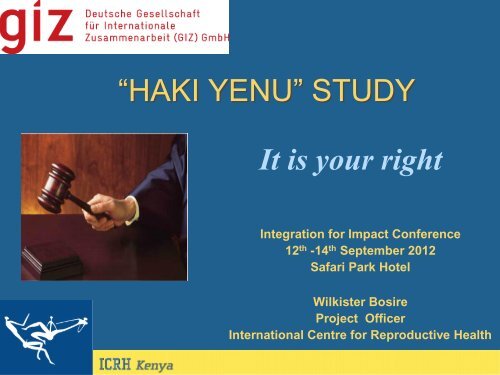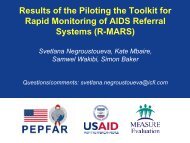âHAKI YENUâ STUDY It is your right - Integration for Impact
âHAKI YENUâ STUDY It is your right - Integration for Impact
âHAKI YENUâ STUDY It is your right - Integration for Impact
You also want an ePaper? Increase the reach of your titles
YUMPU automatically turns print PDFs into web optimized ePapers that Google loves.
“HAKI YENU” <strong>STUDY</strong><br />
<strong>It</strong> <strong>is</strong> <strong>your</strong> <strong>right</strong><br />
<strong>Integration</strong> <strong>for</strong> <strong>Impact</strong> Conference<br />
12 th -14 th September 2012<br />
Safari Park Hotel<br />
Wilk<strong>is</strong>ter Bosire<br />
Project Officer<br />
International Centre <strong>for</strong> Reproductive Health
SGBV Background<br />
• SGBV - most widely spread and socially tolerated <strong>for</strong>m<br />
of human <strong>right</strong>s violations globally<br />
» Public health<br />
» Development<br />
» Results from and propagates gender inequalities<br />
• Worldwide, an estimated 1: 5 women will be a victim of<br />
rape or attempted rape in her lifetime<br />
• 1:3 women will have suffered any abuse by a family<br />
member or acquaintance
SGBV Background cont…<br />
• Hundreds of thousands women and children are<br />
trafficked and enslaved yearly<br />
• Millions are subjected to harmful practices<br />
• Violence kills and d<strong>is</strong>ables as many women (15-44) as<br />
cancer<br />
• <strong>It</strong>s toll on women’s health surpasses that of traffic<br />
accidents and malaria combined
SGBV situation in Kenya/Coast province<br />
• NWH – a person <strong>is</strong> raped every half hour in Kenya<br />
• >1/3 of women have suffered some violence since they<br />
were 15 (KDHS,2008/9)<br />
• 1:5 had experienced sexual violence<br />
• 12% had first sex <strong>for</strong>ced<br />
• GBVRC~50 cases are seen each month<br />
• ~40% report to anyone/12% to someone in authority<br />
(UNAIDS, 2006)
Rationale<br />
• Recognition of SGBV as a crime under local and<br />
international law<br />
• Survivors encounter barriers in accessing justice in Kenya<br />
– Challenges in the implementation of SOA, 2006<br />
– Gaps –medical, psycho social & legal services<br />
• SGBV survivors deserve justice<br />
• Comprehensive framework <strong>for</strong> response to & prevention<br />
– Barriers to accessing services<br />
– Hindrances in coordination-community/legal/medical<br />
– Comprehensive set of policies/leg<strong>is</strong>lations/institutions
Study objectives<br />
Broad objective: To contribute to improved access to justice<br />
<strong>for</strong> survivors of SGBV in Mombasa, Kenya<br />
Primary objectives:<br />
• Legal outcomes of SGBV cases<br />
• Reasons <strong>for</strong> successful or failed prosecution of SGBV cases<br />
• Reasons <strong>for</strong> filing or not filing case in court<br />
Secondary objectives:<br />
• To explore strategies <strong>for</strong> strengthening referrals<br />
• To generate baseline data on legal follow up of SGBV cases<br />
• To evaluate the quality of services at the GBVRC
Research questions<br />
• What are the obstacles surrounding reporting and<br />
pursuing legal justice of SGBV incidents among<br />
survivors of SGBV?<br />
• What are the reasons behind success or failure of a<br />
court case <strong>for</strong> an SGBV survivor?<br />
• What are the determinants of access to medical and<br />
legal services <strong>for</strong> an SGBV survivor?<br />
• How can we strengthen linkages between community<br />
and medico-legal services <strong>for</strong> survivors of SGBV?
Methodology<br />
• Retrospective observational analys<strong>is</strong> ~6mons (Mombasa )<br />
• Qualitative and quantitative research techniques<br />
– Review of court records: 100 SOC selected thro’<br />
proportionate sampling by nature of offense<br />
– Structured interviews: 347 /2646 survivors seen 2007-2011<br />
– KII: 20 –HCP, police investigators/prosecutors,<br />
mag<strong>is</strong>trates, chiefs, govt. chem<strong>is</strong>t analyst, women leaders<br />
– IDI: 20 survivors who went to court & 20 who did not
Expected outputs<br />
• Number of SGBV cases filed in the Mombasa courts and<br />
children’s court between August 2007 and December<br />
2011 that were successfully prosecuted<br />
• Number of SGBV cases filed in the Mombasa courts and<br />
children’s court between August 2007 and December<br />
2011 that were not successfully prosecuted<br />
• Documentation of reasons why some SGBV cases went<br />
through or did not go through successful prosecution<br />
• Documentation of reasons why some survivors who<br />
passed through the GBVRC did not seek legal redress
Expected outputs cont…<br />
• Documentation of strategies <strong>for</strong> strengthening referrals<br />
from the community and between the medical and legal<br />
service providers<br />
• Documentation of the survivors’ perception of justice<br />
versus the criminal justice system and survivor<br />
sat<strong>is</strong>faction with sentences meted to persons found<br />
guilty of sexual violence<br />
• Policy recommendations in leg<strong>is</strong>lation, court procedures,<br />
community involvement, effective prosecution, real<strong>is</strong>tic<br />
and targeted in<strong>for</strong>mation <strong>for</strong> survivors, advocacy<br />
in<strong>for</strong>mation <strong>for</strong> groups on protection of survivors,<br />
objective in<strong>for</strong>mation <strong>for</strong> the media
Current status<br />
• Recruited staff<br />
• Received ethical approval from KNH ERC<br />
• Await research permit from NCST
Thank you





